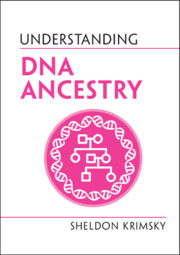Book contents
- Understanding DNA Ancestry
- Series page
- Understanding DNA Ancestry
- Copyright page
- Reviews
- Dedication
- Contents
- Foreword
- Acknowledgments
- 1 Introduction
- 2 The Business of DNA Ancestry
- 3 What Our Genomes Tell Us about the Geographical Origins and Movements of Early Human Populations
- 4 The Science behind DNA Ancestry Testing
- 5 Ancestry Informative Markers
- 6 Ancestry DNA Population Reference Panels
- 7 Comparing a Donor’s DNA to Reference Panel Populations
- 8 Probing Your DNA
- 9 Forensic Applications of Ancestry DNA Results
- 10 Privacy, Personal Identity, and Legal Issues
- 11 Discovering Unknown, Missing, or Mistaken Relatives
- 12 Accuracy, Consistency, and Validation of DNA Ancestry Tests
- 13 Conclusion
- Summary of Common Misunderstandings
- References
- Index
- Other books authored, coauthored, or coedited by Sheldon Krimsky
5 - Ancestry Informative Markers
Published online by Cambridge University Press: 05 March 2022
- Understanding DNA Ancestry
- Series page
- Understanding DNA Ancestry
- Copyright page
- Reviews
- Dedication
- Contents
- Foreword
- Acknowledgments
- 1 Introduction
- 2 The Business of DNA Ancestry
- 3 What Our Genomes Tell Us about the Geographical Origins and Movements of Early Human Populations
- 4 The Science behind DNA Ancestry Testing
- 5 Ancestry Informative Markers
- 6 Ancestry DNA Population Reference Panels
- 7 Comparing a Donor’s DNA to Reference Panel Populations
- 8 Probing Your DNA
- 9 Forensic Applications of Ancestry DNA Results
- 10 Privacy, Personal Identity, and Legal Issues
- 11 Discovering Unknown, Missing, or Mistaken Relatives
- 12 Accuracy, Consistency, and Validation of DNA Ancestry Tests
- 13 Conclusion
- Summary of Common Misunderstandings
- References
- Index
- Other books authored, coauthored, or coedited by Sheldon Krimsky
Summary
If human populations in different geographical regions can be identified by DNA, while the vast amount of human DNA is identical, then, in the regions or places on the genome that are variable, there must be markers that reveal biogeographical regions of origin. DNA polymorphisms (letter changes in the nucleotides) are currently the choice markers because most human polymorphisms are characterized by alleles that are unevenly distributed among the world’s distinct populations.
Keywords
- Type
- Chapter
- Information
- Understanding DNA Ancestry , pp. 41 - 49Publisher: Cambridge University PressPrint publication year: 2021

